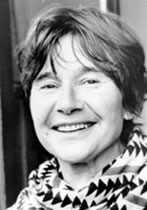Memories of childhood
Rita Törnqvist excels in autobiography. She first became known for her outstanding translations of Astrid Lindgren’s work. In 1976 she began writing her own books for young readers. Wie is hier eigenlijk de baas? (Who’s Actually In Charge Here?, 1977) is the result of correspondence between the author and her 11-year-old daughter Marit Törnqvist, now a successful illustrator. It was followed by a cheerful trilogy about the fantasy-filled children Heleen and Waldemar. In Ze snappen er niets van (They Just Don’t Get It, 1978), Wat je zegt ben je zelf (It Takes One to Know One, 1977) and Kinderen en gekken (Children and Fools, 1978) light-hearted rebellion and childlike logic are confronted with the actions and thoughts of adult educators. In 1993 Hoe moet dat nu met die papillotten (What About the Curl Papers?) appeared, the first part of an autobiographical cycle in which the author recounts memories of the Second World War. Rita Törnqvist has an exceptional capability to recreate the mental and emotional world of the child she once was. Everything seems authentic and plausible. The poetic undertone, the childlike amazement and the touching humour with which she accomplishes this have won her a distinguished place in the world of Dutch children’s books.

Rita Törnqvist (photo Van Goor)
Memories of childhood provide a favourite source for Henri van Daele as well. Village life in the time before the advent of video shops, discos and solariums plays an important role in his youth books. In Pitjemoer (1980), Pitjefaan (1983) and Mitjemoer (1984) he brings to life the Flemish countryside of forty years ago through the eyes of his grandparents, while Ti (1996) tells the story of a typical village beggar. Henri van Daele is a brilliant narrator and observer. In short, pithy sentences he describes recognisable situations and recounts Flemish-sounding dialogues. Van Daele is also revered as a teller of classic stories from world literature.
Search Website
Essays (English)
- Judges' Report. Vondel Translation Prize 2009 Paul Binding, Susan Massotty, Ina Rilke
- Character. On Character by F. Bordewijk By Cees Nooteboom
- Dark Poetry and Ambiguity. On the The Darkroom of Damocles by W.F. Hermans By Milan Kundera
- Waiting for a Pioneer. The Development of the Dutch Thriller By Gijs Korevaar
- Young poets, packed houses. Dutch poetry from the eighties to the present By Tatjana Daan
- Beauty and Truth neighbours once more. Literary Non-Fiction in the Netherlands and Flanders By Ger Groot
- God's Fingerprint. Modern Dutch Prose By Onno Blom
- A Quilt of Many Colours. Contemporary Children's Books By Annemie Leysen
- Between the Individual and Society. Postwar Prose in Holland and Flanders By Jaap Goedegebuure
- There Is No Such Thing as Dutch Literature. Dutch Literature Seen From Abroad By Hermann Wallmann
- A Walk on the Wild Square. Poetry of the 1980s and 1990s By Paul Demets
Essays (Nederlandstalig)
- Homeros bijna nabij? Een Iliasvertaling door Patrick Lateur
- Verzoening met het eigen werk door Anneke Brassinga
- 'The Windhover' van Gerard Manley Hopkins door Maarten Elzinga en Koen Stassijns
- 'Stamboom' van Rozalie Hirs
- Over het vertalen van De Danser van Nijhoff door David Colmer
- 'Verhuizen' van Peter Theunynck door Ira Wilhelm en Ard Posthuma
- Ontroerd door afstand door David Colmer
- Juryrapport. Phares du Nord Prijs 2009 door Danielle Bourgois, Margot Dijkgraaf, Annie Kroon
- Dankwoord Anita Concas door Anita Concas
- De vondsten van een kinderboekvertaler door Rolf Erdorf
- Serendipity. Of de betrekkelijkheid van vondsten door Barber van de Pol
- Het huiswerk van de taalman door Pjeroo Roobjee
- Een staat van genade. Vertaalvondsten door Peter Verstegen
- Op de Berlagebrug. Over het vertalen van liedteksten door Jan Boerstoel
